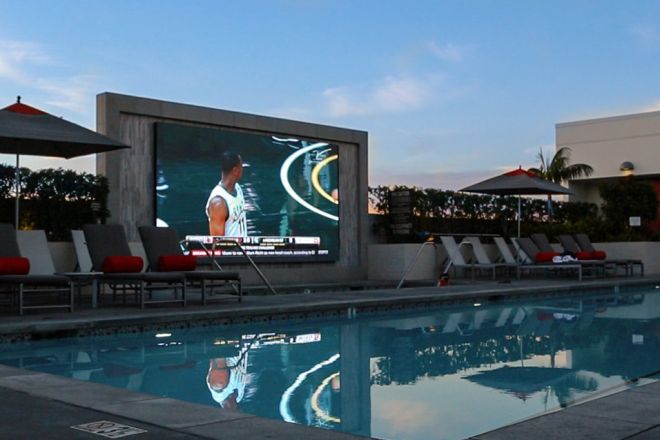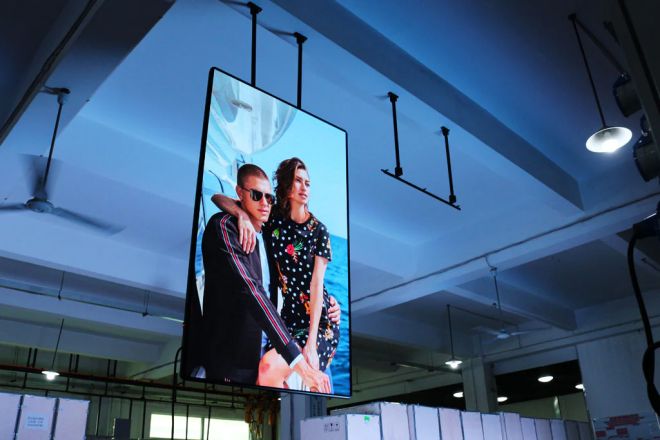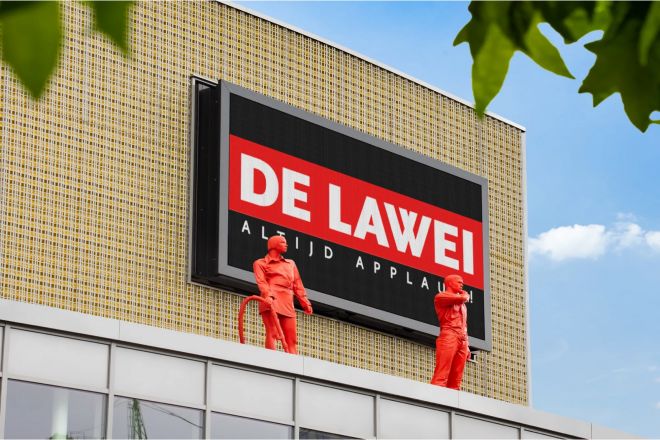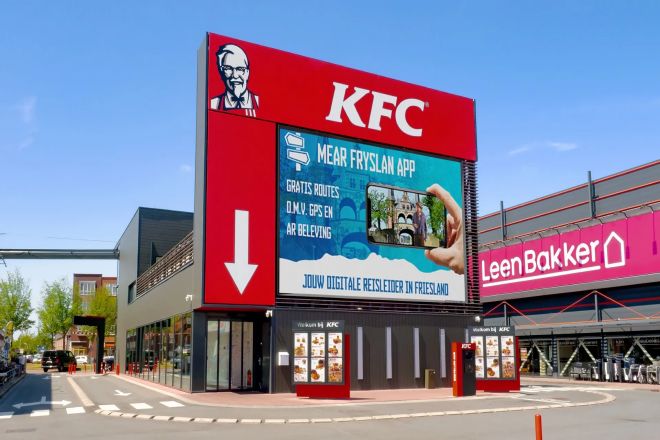序章

科学技術の急速な発展により、 LED表示画面 have become an important carrier of urban landscape and information dissemination.
From bustling commercial streets to quiet parks, LED display screens are everywhere, adding vitality to the city and providing us with rich information. However, with the acceleration of urbanization and the growing demand for information, the limitations of traditional LED display screens have gradually become prominent, such as low resource utilization and single information release channels.
Against this background, the concept of shared LED display screens came into being. With its unique advantages and potential, it has become a new trend in future urban information displays.
1. The concept and characteristics of shared LED display screens
Shared LED display screens are a new type of outdoor display device that breaks through the limitations of the single-use and fixed installation of traditional LED display screens and incorporates the concept of “sharing.”
Compared with traditional LED display screens, shared LED display screens not only have the display effects and advertising functions of traditional LED display screens but, more importantly, they can enable multiple users or organizations to share the same LED display screen through a sharing mechanism, thereby maximizing resource utilization and reducing costs.
Feature Analysis:
- 多用途性
Shared LED display screens have strong versatility and can meet multiple needs such as advertising, information release, and public publicity at the same time. Merchants can use it to publish product advertisements, government agencies can issue policy announcements, and community organizations can play public publicity videos. This versatility makes shared LED display screens an important window for urban information release and provides strong support for the city’s informatization process.
- 柔軟性
The design of shared LED display screens makes them highly flexible. On the one hand, it can be moved to different locations for use according to actual needs; on the other hand, it can also be reconfigured to meet the needs of different sizes and shapes by splicing different numbers of display units.
This flexibility enables shared LED display screens to adapt to the needs of various occasions and environments, providing more possibilities for the display of urban information.
- Intelligence
Shared LED display screens integrate advanced technologies such as the Internet of Things and big data to achieve remote monitoring and intelligent management. Through the Internet of Things technology, users can achieve remote control and real-time monitoring of the display screen, including power on and off, brightness adjustment, content update, etc.
At the same time, big data technology can help users analyze the use and effect of the display screen and provide data support for subsequent operations and decision-making. This intelligent management not only improves the efficiency of the display screen but also reduces maintenance costs.
2. Feasibility Analysis of Shared LED Display Screens

- Technical Feasibility
Current technical conditions have provided strong support for the realization of shared LED display screens. After years of development, LED display screen technology has the characteristics of high definition, high brightness, high stability, etc., which can meet the display needs of various occasions.
At the same time, the rapid development of technologies such as the Internet of Things and big data has provided a technical basis for remote monitoring and intelligent management of shared LED display screens. Therefore, from a technical point of view, it is not difficult to realize shared LED display screens.
- Economic Feasibility
From an economic point of view, shared LED display screens are highly cost-effective and profitable. First, through the sharing mechanism, multiple users or organizations can use the same display screen together, reducing the cost of a single user. Secondly, the advertising function of the display screen can bring advertising revenue to the enterprise, further improving profitability.
Finally, with the acceleration of urbanization and the growth of people’s demand for information, the market demand for shared LED display screens will continue to grow. According to market research data, the market size of the LED display screen industry continues to grow, and it is expected to maintain a relatively fast growth rate in the next few years.
Therefore, from an economic point of view, shared LED display screens are highly feasible.
- Social Feasibility
From a social point of view, shared LED display screens have a positive impact on the image of the city, public services, and cultural communication. First, as an important information window of the city, the shared LED display can display the image and culture of the city and improve the city’s visibility and reputation.
Secondly, by publishing public information such as government announcements, traffic information, and weather forecasts, the shared LED display can provide the public with convenient information services and improve the city’s service level.
Finally, the shared LED display can also serve as an important carrier of cultural propaganda, displaying the city’s cultural characteristics and historical heritage and promoting the dissemination and exchange of culture. Therefore, from a social perspective, the shared LED display is highly feasible.
3. Advantages of shared LED display
- Resource optimization
One of the biggest advantages of a shared LED display lies in its resource optimization capability. Through the sharing mechanism, multiple users or organizations can use the same display together, which greatly improves the utilization rate of LED displays.
In the past, each organization or enterprise may have needed to purchase and install LED display screens separately, which not only increased costs but also led to a waste of resources.
The shared LED display screen, through centralized management and scheduling, enables the display screen resources to be more reasonably configured and used, thereby reducing the waste of resources.
- Maximizing benefits
Another advantage of shared LED display screens is that they can achieve a win-win situation in terms of economic and social benefits. For investors and operators, by providing diversified services (such as advertising, information display, cultural propaganda, etc.), shared LED screens can create more sources of income and maximize economic benefits.
At the same time, for governments, enterprises, and the public, shared LED screens provide convenient channels for information release and acquisition, promote the circulation and exchange of information, and improve the level of public services, thereby maximizing social benefits.
- Information Sharing
Shared LED screens also play an important role in information sharing. As a public display platform, it can carry various information content, including government announcements, traffic information, weather forecasts, commercial advertisements, etc.
This information can not only help the public better understand the city’s dynamics and life information but also strengthen information exchange and communication between the government, enterprises, and the public.
Through shared LED screens, all parties can transmit information more efficiently and promote the sharing and utilization of information.
- Innovation-driven
The emergence of shared LED screens has also promoted the development of urban informatization, intelligence, and greening. As a new type of display technology, shared LED screens integrate advanced technologies such as the Internet of Things and big data, providing strong support for urban informatization and intelligence.
At the same time, due to the energy-saving and environmentally friendly characteristics of LED screens, the promotion and use of shared LED screens will also help promote the green development of cities.
Through continuous innovation and optimization, shared LED display screens will play an increasingly important role in the process of urban informatization and intelligence.
4. Application scenarios of shared LED display screens

- 商業広告
Shared LED display screens provide merchants with an efficient and accurate advertising platform. Merchants can display their products or services through shared LED display screens to attract more potential consumers.
Because LED display screens have a strong visual impact, they can attract the attention of passers-by on busy city streets so that advertising content can be more widely disseminated.
At the same time, through the advertising management system of shared LED display screens, merchants can set the time, content, and frequency of advertising according to their own needs to achieve precision marketing.
- 公共サービス
Shared LED display screens play an important role in the field of public services. The government can publish various announcement information, such as policy interpretation, important notices, etc., through shared LED display screens so that the public can understand the government’s work and decision-making more timely and comprehensively.
In addition, shared LED display screens can also be used to publish public service information, such as traffic information and weather forecasts, to help citizens arrange travel and life reasonably.
The timely release of this information is of great significance to improving the level of urban public services and enhancing citizens’ sense of gain and happiness.
- Cultural publicity
Shared LED display screens are an important carrier for displaying urban cultural and tourism resources. By playing city promotional videos, travel videos, and other content, tourists can have a deeper understanding of the city’s history, culture, customs, and tourism resources.
In addition, when holding major events or celebrations, shared LED screens can also be used as an important display tool at the event site, and the atmosphere and influence of the event can be enhanced by playing event videos and live broadcasts.
- Emergency response
In emergencies, shared LED screens can play an important role in emergency response. By quickly releasing early warning information and rescue instructions, citizens can be helped to understand the disaster situation and response measures in a timely manner and reduce the losses caused by disasters.
For example, when a natural disaster occurs, a shared LED screen can release disaster warning information, shelter guides, and other content; when a traffic accident occurs, traffic control information, rescue progress, and other content can be released.
The timely release and communication of this information is of great significance to improving citizens’ emergency response capabilities and self-rescue and mutual rescue capabilities.
5. Challenges and countermeasures of shared LED screens
1). Challenge Analysis
1.1). Technical challenges:
Standardization and compatibility: LED screens of different brands and models have differences in interfaces, protocols, etc., resulting in compatibility issues when sharing.
Remote monitoring and intelligent management: Remote monitoring and intelligent management require strong technical support, including the Internet of Things, big data, and cloud computing.
Data security and privacy protection: Shared LED display screens may face the risk of data leakage and privacy infringement in the process of collecting, processing, and publishing information.
1.2). Management challenges:
Operation and maintenance: Shared LED display screens require a professional operation team to perform daily maintenance and troubleshooting to ensure the normal operation of the equipment.
Content review and supervision: In the release of advertisements, information and other content, strict content review and supervision mechanisms are required to prevent the spread of bad information.
User coordination and benefit distribution: When multiple users share the same display screen, it is necessary to coordinate the interests of all parties to ensure fair and just use.
1.3). Policy challenges:
Lack of laws and regulations: At present, the laws and regulations on shared LED display screens are not perfect, which may lead to some legal disputes and regulatory gaps.
Insufficient policy support: The government’s support for shared LED display screens is limited, which may affect its promotion and application.
2). Countermeasures and suggestions
2.1). Strengthen technical research and development:
Promote the standardization process of LED display screens and solve compatibility issues.
Strengthen the research and development and application of technologies such as the Internet of Things, big data, and cloud computing to improve the level of remote monitoring and intelligent management.
Strengthen the research and application of data security and privacy protection technologies to ensure information security.
2.2). Improve the management system:
Establish a professional operation team to be responsible for the daily maintenance and troubleshooting of shared LED display screens.
Establish a strict content review and supervision system to prevent the spread of bad information.
Establish a user coordination mechanism to ensure that the interests of all parties are fairly and impartially protected.
2.3). Strive for policy support:
Strengthen communication and cooperation with the government, and strive for government support in terms of laws, regulations, and policy support.
Actively participate in the work of industry associations, standard setting organizations, etc. to promote the development and standardization of the industry.
Strengthen cooperation and exchanges with other relevant companies and organizations to jointly promote the development and application of shared LED display screens.
6. Future development trends of shared LED display screens

1). 技術革新
- 高解像度:
With the advancement of technology, the pixel density and color expression of shared LED display screens will be further improved to achieve higher-definition display effects. This will make advertisements, information, and other content clearer and more vivid when displayed on the display screen.
- よりインテリジェント:
Shared LED display screens will integrate more intelligent technologies, such as the Internet of Things, big data, and artificial intelligence.
Through remote monitoring and intelligent management, the functions of automatic control of the display screen and intelligent content recommendation can be realized to improve the use efficiency and user experience.
- More energy-saving and environmentally friendly:
LED display screens themselves have the characteristics of energy saving and environmental protection. In the future, shared LED display screens will pay more attention to energy-saving design and adopt more efficient LED chips, drive circuits, etc., to reduce energy consumption and carbon emissions.
2). Model Innovation
- Business model:
With the expansion of the market and the growth of demand, the business model of shared LED display screens will continue to innovate. For example, a more flexible leasing model can be adapted to meet the personalized needs of different users; it can also establish cooperative relationships with advertisers, content providers, etc., to achieve a win-win situation for all parties.
- Service model:
The service model of shared LED display screens will also continue to innovate. For example, customized services can be provided to design unique display content and forms according to user needs and scenarios; data analysis services can also be provided to help users better understand the use and effect of the display screen.
3). Market Expansion
- Domestic market:
With the acceleration of urbanization and the growth of people’s demand for information, shared LED display screens have huge expansion potential in the domestic market. Especially in the fields of commercial advertising, public services, cultural propaganda, etc., shared LED display screens will play an increasingly important role.
- International market:
The internationalization trend of shared LED display screens is also becoming increasingly obvious. By participating in international exhibitions and expanding overseas markets, China’s shared LED display products and technologies can be promoted to the international market and achieve a global layout.
4). Policy support
Given the important role of LED displays in promoting the informatization, intelligence, and green development of cities, the government should increase its support for the shared LED display industry.
This includes formulating more favorable tax policies, providing financial support, and strengthening support in technology research and development and talent training. At the same time, the government should also strengthen industry supervision and standard formulation to ensure the healthy and orderly development of the shared LED display industry.
結論
Looking back at the full text, shared LED displays are gradually becoming a new favorite in the process of urban informatization with their unique advantages and potential. It can not only improve the utilization rate of LED displays and reduce resource waste but also achieve a win-win situation of economic and social benefits through diversified services.
At the same time, shared LED displays have a wide range of application scenarios; whether in commercial advertising, public services, cultural propaganda, or emergency response, they can play an important role.
最後に、LEDディスプレイについてもっと知りたい方は、 ご連絡ください。
